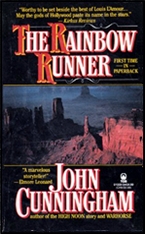Mon 23 May 2022
A Western Fiction Review by David Vineyard: JOHN CUNNINGHAM – The Rainbow Runner.
Posted by Steve under Reviews , Western Fiction1 Comment
JOHN CUNNINGHAM – The Rainbow Runner. Tor, hardcover, 1992; paperback, 1993.

West Pointer and former Rough Rider Jacko O’Donohue of O’Donohue and Horton Export/Import has good reason to worry about being shot at. He and his partner Mike Horton are more private detectives than importers, and Jacko’s life is complex by any standards.
His family owes money they can’t raise or they will lose their California vineyards, his wife married him expecting riches and comfort that Jacko couldn’t give her, his old “friend†and partner Mike Horton is blackmailing clients according to the D. A. (“Where’d they get the idea of blackmail? They don’t like me, never did.â€), and Mike and Jacko’s wife May are having an affair.
So when the Mexican Consul in Los Angeles, Manuel Palafox, a frequent client of O’Donohue and Horton for whom they spy on local anarchists, offers Jacko a considerable fee to escort a religious artifact that was smuggled out of Mexico by would-be anarchists, a monstrance worth a quarter of a million dollars stolen from the church in San Luis Potosi, back to its rightful place it seems like a solution to all his problems.
But that may not be as simple as it seems, not with Palafox’s dangerous half-brother Herculano, the revolutionaries in L.A. who stole the relic in the first place and moved it out of Mexico, the forces of the Pancho Villa’s army in Mexico, and the treacherous Mike and May simply surviving may be all Jacko can manage.
Jacko went over his Tactical Rules. Number 1: the most effective offense as well as the most difficult is to take the enemy by surprise from the rear. Number 2: in the rear from an elevated position. Number 3: in the rear by enfilade. All these West Point abstractions were subsumed under the general heading of Backshooting.
While this may sound like a private eye novel (there was never all that much difference between the two), and a fairly hard-boiled one at that, The Rainbow Runner, is, in fact, a Western (though one that would not have been out of place in Black Mask), and by a fairly well known Western writer, John Cunningham, a highly praised master of the form well known for his fine novel of the trail drives, Warhorse, and a little story called “The Tin Star†filmed under the more familiar name of High Noon.
The high quality of the writing (… his small feet adventuring timidly, one after the other, like a pair of old married mice out of a hole.) the well-developed characters, and the sense that everything arises naturally from the characters and plot as set in motion mark this as a classic adventure story as Jacko gets involved reluctantly with Becky (“I can see you, scuttling along behind me, terrified because you think you might have to protect me.â€), Mike’s wife and tries to survive against a background of treachery and violent terrain.
Everyone is out for themselves and everyone has a hidden agenda. No one can be trusted, and Jacko isn’t all that sure of himself or his own motives. All he knows is his life has come apart and now delivering that religious relic may mean the end of it.
Here he evokes the divided border town of Nogales as sharply as Berlin divided by the Wall:
Cunningham is often ranked with writers like Jack Shaefer and A. B. Guthrie as a Western writer, and here blurbed by Guthrie, Elmore Leonard, Alan LeMay, Douglas C. Jones, and reviewed in The New Yorker. His bona fides as a writer of Westerns are top notch.
This and his novel Starfall came along late in his career and are both well worth finding. Four novels and a classic short story aren’t a prolific career, but when they are all this good quality weighs far more than quantity.
May 23rd, 2022 at 9:23 pm
This one totally escaped my attention when it came out. But a PI western? And a grand glorious adventure novel to boot. What’s not to like?